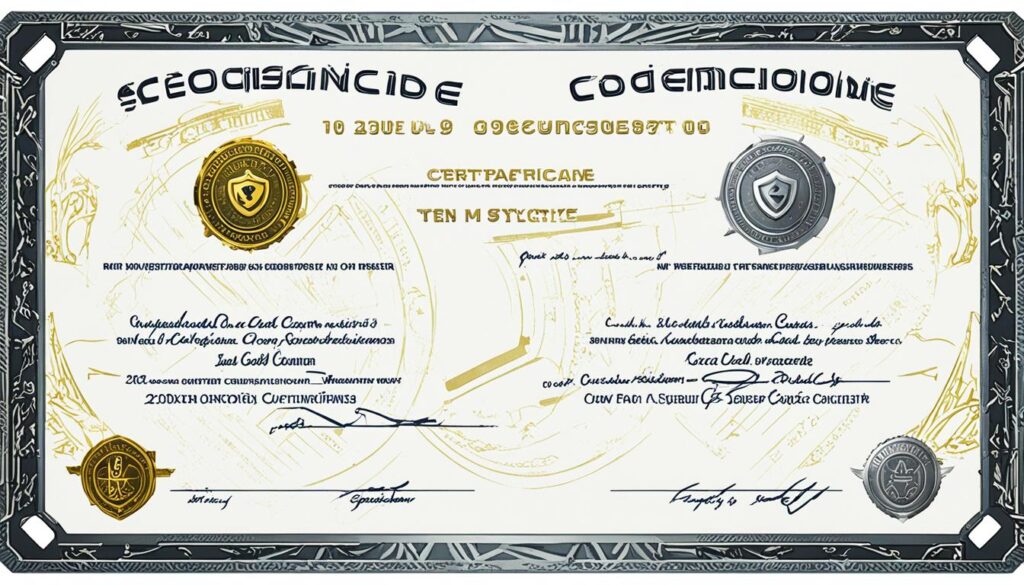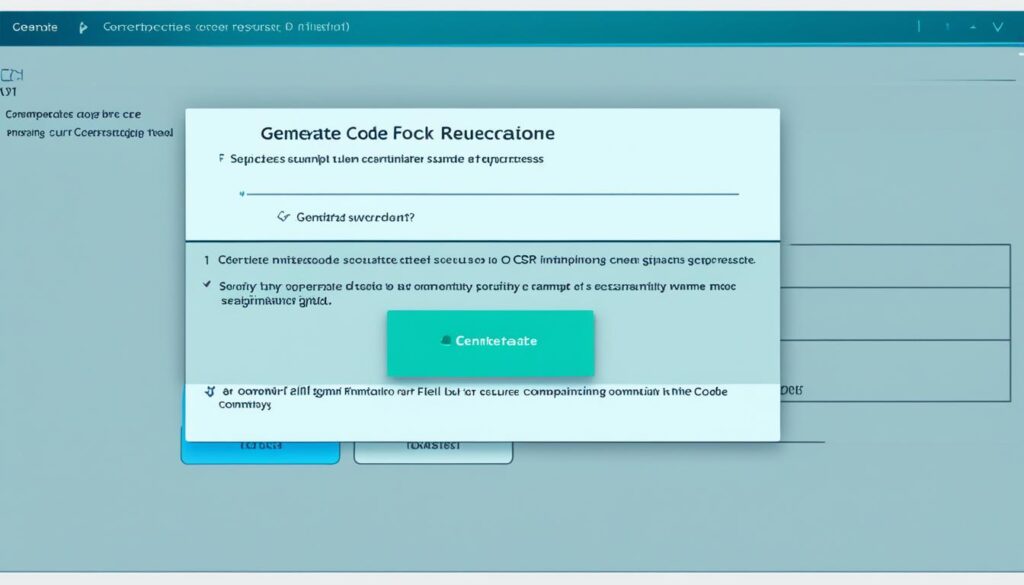In today’s digital landscape, a staggering 70% of software users in the United States cite security concerns as a reason for avoiding software downloads. This stat accentuates the need for robust software protection strategies, where the code signing certificate process plays a pivotal role. For software publishers, obtaining a code signing certificate is not just an additional layer of security; it’s an essential factor in ensuring user trust and software integrity.
Imagine a world where you could distribute your software with the assurance that no one could tamper with it. That’s the promise of code signing certificates. As you delve into the code signing certificate benefits, it’s clear that with the right steps, your software and your reputation are safeguarded, laying the foundation for a trusted digital ecosystem.
Key Takeaways
- Understanding the importance of a code signing certificate is essential for enhancing software security and user trust.
- Selecting the right certificate provider is crucial in the code signing certificate process.
- The validation steps involved are stringent but necessary for maintaining software integrity.
- Installing a code signing certificate correctly contributes to the overall security of the distribution process.
- Exploring the various code signing certificate benefits can reveal how certificates can impact user perception and trust.
Understanding Code Signing Certificates
In today’s digital landscape, the security of software distribution is paramount. Code signing certificates play a vital role in maintaining the integrity of software applications by assuring users of their authenticity. This ensures that any code or executables they download are safe to run and have not been tampered with since the original publisher released them.
What is a Code Signing Certificate?
A code signing certificate is a type of digital signature that provides security for software, applications, and scripts. It ensures that the code has not been altered or corrupted and verifies the identity of the software publisher. These certificates are essential for building trust with end-users, as they can be confident that the software they download comes from a recognized and vetted source.

The Importance of Code Signing for Software Security
Integrating code signing certificates into the software release process is critical for protecting end-users from malware and other malicious exploits. They are a fundamental component of a robust cybersecurity strategy, and understanding the code signing certificate requirements is necessary for any software distributor to maintain trust and integrity in the realm of software security.
How Code Signing Works
The process of code signing involves the use of cryptographic hash functions. When a developer signs their code, the signing algorithm creates a hash of the code and then encrypts this hash with the developer’s private key. The end-user’s software, upon downloading such files, decrypts the hash using the public key in the code signing certificate. If the calculated hash over the downloaded file matches the decrypted hash, it ensures that the integrity of the code is intact.
| Best Practice | Description | Benefit |
|---|---|---|
| Proper Storage of Private Keys | Securing the private key used for signing against unauthorized access. | Reduces the risk of code being fraudulently signed or certificate compromise. |
| Regular Audits | Performing systematic checks on code signing activities. | Ensures compliance with security policies and detects potential vulnerabilities early. |
| Using Timestamping | Adding a timestamp to the code signature to verify when the code was signed. | Keeps the integrity of the code intact even after the code signing certificate expires. |
| Revocation Checks | Checking the revocation status of the code signing certificate regularly. | Ensures the certificate is still valid and has not been revoked due to compromise. |
Adhering to the best practices for code signing certificates not only enhances the security of the signed code but also the trust end-users have in your software. By fulfilling these requirements and practices, software publishers can significantly mitigate the risks associated with software distribution and maintain a healthy security posture.
Choosing the Right Certificate for Your Needs
When it comes to securing your software distribution, the selection of an appropriate code signing certificate is a decisive step toward protecting your products and reputation. Understanding the types and features of code signing certificates that various providers offer is essential to ensure your choice meets your software’s and organization’s requirements.
Types of Code Signing Certificates
Generally, there are two main types of code signing certificates to consider: Organization Validation (OV) and Extended Validation (EV). OV certificates are standard and validate the software company’s identity, ensuring users that the software they download is legitimate. On the other hand, EV certificates go the extra mile by offering a higher level of security and requiring a more comprehensive validation process which can increase user trust even further.
Comparing Code Signing Certificate Providers
Deciding on a code signing certificate provider involves comparing characteristics like cost, the code signing certificate validity period, and support for different platforms. Let’s take a closer look at two leading code signing certificate providers, DigiCert and Sectigo, and how they stack up against each other.
| Feature | DigiCert | Sectigo |
|---|---|---|
| Validation Levels Offered | OV, EV | OV, EV |
| Validity Period Options | 1-3 Years | 1-5 Years |
| Reputation | Well-established in industry | Known for affordability |
| Customer Support | 24/7 via multiple channels | 24/7 via multiple channels |
| Additional Features | High assurance EV, Multi-domain support | Step-up EV upgrade, Free Trust Logo |
Understanding the code signing certificate validity period is also critical, as it dictates how long your software will maintain its verified status before needing to renew the certificate. You will want to balance the length of validity with your software update and release cycle, ensuring consistent trust with your users.

Ultimately, the correct certificate for your needs will depend on the level of assurance your customers require and the type of software you are distributing. Factors such as company size, budget, and the need for global recognition should influence your decision-making process. Ensuring secure software starts with the foundation of choosing the right code signing certificate provider.
How to Obtain Code Signing Certificates
Securing a code signing certificate is crucial for software developers seeking to establish trust and provide security assurances to end users. This process, while seemingly complex, can be navigated with ease by following a set of clear steps. DigiCert, a leading certificate authority, offers a streamlined approach to how to obtain code signing certificates and ensures a smooth code signing certificate installation.

Prospective certificate holders begin by selecting the appropriate product to match their needs. Whether you’re an individual developer or a large enterprise, your choice of a code signing certificate will depend on the level of validation you desire and the types of platforms you’ll be supporting. Next, determine the duration of the certificate’s validity. Generally, developers opt for one to three years, balancing cost with convenience.
When submitting your request, accuracy and completeness of the information you provide are paramount. DigiCert requires detailed contact information along with organizational details that undergo rigorous validation to uphold the security standards expected by users worldwide. Here’s a quick checklist to prepare your application:
- Select the appropriate code signing certificate product
- Decide on the validity period (1-3 years)
- Provide accurate organizational and contact details for validation
- Specify technical contact details, if different from the requester’s information
DigiCert’s commitment to security means that the verification process is thorough, ensuring that only legitimate entities can acquire and deploy code signing certificates.
The table below outlines common considerations when obtaining a code signing certificate:
| Consideration | Description | Impact |
|---|---|---|
| Product Type | Choice between OV and EV certificates | Affects level of trust and platform compatibility |
| Validity Period | Typically 1 to 3 years | Balances cost against frequency of renewal |
| Organizational Details | Information needed for certificate issuance | Ensures authenticity and integrity of the entity |
| Technical Contact | May differ from the corporate contact | Allows direct communication during the validation process |
With DigiCert’s guidance, obtaining and installing a code signing certificate becomes an intuitive process that integrates seamlessly into your software distribution strategy. Commit to the security of your application today by taking the necessary steps to acquire a certified seal of trust.
The Role of Validation in the Code Signing Process
Ensuring the security and integrity of code through the code signing certificate process is of utmost importance for developers and organizations alike. Validation serves as the cornerstone of this process, providing confidence to all stakeholders that the software they are using is safe and trustworthy. Let’s delve into the specific types of validation that enhance the security of code signing.
Organizational Validation for Code Signing
Organizational Validation (OV) is a key component in certifying the legitimacy of a business entity in the code signing certificate process. The Certificate Authority (CA) rigorously verifies the existence and operation of the organization to avoid potential fraud. Below are the benefits of OV in the code signing process:
- Establishes trust with users by validating company details
- Supports non-repudiation by linking the signature to the corporate entity
- Assures that the software has not been tampered with after signing

Extended Validation (EV) for Enhanced Security
Extended Validation (EV) certificates represent the gold standard in the code signing certificates’ sphere. They demand a more extensive verification process and come with a range of additional security and assurance measures. The code signing certificate benefits with EV include:
- Higher level of trust from users and operating systems
- Instant reputation with browsers and other software
- Stricter security measures to prevent key compromise and impersonation
The table below compares the benefits of Organizational Validation and Extended Validation for code signing certificates:
| Verification Level | Validation Requirements | User Trust Level | Security Features |
|---|---|---|---|
| Organizational Validation (OV) | Verification of organization’s existence and operation | Standard trust for desktop OS and web browsers | Basic encryption and signature validity |
| Extended Validation (EV) | Comprehensive vetting including legal, physical, and operational checks | High trust with immediate recognition and reputation | Advanced security with enforced hardware token storage of private keys |
By following the rigorous standards set for OV and EV, developers and organizations can leverage these validations to not only improve their software security but also to fortify their reputation among users as trustworthy providers.
Generating Your Certificate Signing Request (CSR)
Every developer looking to secure their software needs to understand the critical code signing certificate requirements involved in generating a Certificate Signing Request (CSR). This procedural step is pivotal and sets the foundation for the issuance and management of your code signing certificate.
Initiating the creation of a CSR typically involves utilizing particular browsers that support such operations. Noteworthy among them are Mozilla Firefox ESR and Internet Explorer 11. These browsers are equipped with the functionality to generate a key pair that constitutes the CSR and the accompanying private key, essential for your application’s security.

Fulfilling the CSR form is an exercise in precision. It mandates furnishing exact details ranging from your organization’s name to the software’s domain names that the code signing certificate will protect. This attention to detail ensures that the certificate authority can adequately verify and authenticate your identity as a software publisher.
The code signing certificate cost is influenced by the type of certificate and the level of validation needed. Prices may vary according to the chosen certificate authority and the assurance level required for your specific needs. It’s advisable to consider both initial costs and potential renewal expenses when evaluating your options.
| Browser | Support for CSR Generation | Suggested Use |
|---|---|---|
| Mozilla Firefox ESR | Yes | Ideal for organizations looking for extensive compatibility |
| Internet Explorer 11 | Yes | Recommended for legacy applications that require it |
To conclude, being informed about both the code signing certificate requirements and the associated code signing certificate cost is essential when navigating through the CSR generation stage. By meticulously following the steps and recommendations outlined by your chosen platform and certificate authority, you can ensure a smooth experience towards securing your code.
Code Signing Certificate Installation
Successfully completing the validation and issuance phase brings you to the vital task of code signing certificate installation. This is where you ensure the security measures you’ve taken come to fruition, enabling users to trust your software’s integrity. Ensuring a smooth installation process is as important as the security it upholds.
The installation might vary slightly depending on the certificate authority, but the procedure typically involves certain universal steps. Here’s what to expect:
- Download the Certificate: Retrieve your code signing certificate from the certificate authority. Remember, it’s essential to use the same browser you utilized for generating your CSR.
- Export the Certificate and Private Key: Unless pre-installed on a hardware token, you’ll need to export your certificate with the private key. This ensures you can securely sign code on your chosen software.
- Install Across Necessary Platforms: Import the certificate into the platforms where you’ll be signing code, be it Windows, macOS, or others.
- Backup Your Certificate and Key: Secure backups of your certificate and key are necessary to prevent any loss or accidental deletion.
Below is a simplified tableau representing the essential steps involved in the installation process for a DigiCert code signing certificate:
| Step | Detail | Note |
|---|---|---|
| 1. Log in to your account | Access your DigiCert management console | Use provided credentials after purchase |
| 2. Download certificate | Find your issued certificate for download | Use the same browser used for CSR creation |
| 3. Export with the key | Export the certificate and private key for use | Often done through a browser or management console |
| 4. Install on platform(s) | Install the certificate on your required platform | May differ for each operating system or platform |
| 5. Backup | Securely backup the certificate and key files | Critical to prevent loss or disruption |
Note that HTTPS-secured platforms for downloading and managing your certificate further ensure your security throughout this process, highlighting one of the crucial benefits of code signing.
For those unfamiliar with the intricacies of code signing certificate installation, dedicated technical support is available from certificate authorities like DigiCert. It’s recommended to leverage these resources to help navigate through the installation process without any hassles.
Best Practices for Secure Code Signing
Ensuring secure code signing is an integral part of software development that upholds the integrity and reliability of your applications. To foster trust with users, it’s essential to follow established best practices for code signing certificates. With the aim of providing a secure software environment, here are two pivotal areas to focus on for securing your digital signature.
Protecting Private Keys
The cornerstone of a secure code signing process is the private key used to create the signature. It’s imperative to regulate access to private keys, as their exposure could lead to malicious parties tampering with your software. Implement strong physical and digital safeguards, such as hardware security modules (HSMs) or secure cryptographic devices, to mitigate the risk of unauthorized access to these sensitive assets. Applying stringent access controls and auditing key usage regularly can significantly reinforce the security of your code signing practices.
Using Timestamping in Code Signing
Another code signing certificate benefit is the ability to utilize timestamping in your signing process. Timestamping your code signatures ensures that your software remains verifiable even after the certificate’s expiration date. This adds an extra layer of credibility, showing that the code was signed during a time when the certificate was valid—essentially future-proofing the signature against potential certificate expiration issues.
Code Signing for Open Source Projects
Open source software development has reshaped the landscape of technology and innovation. However, ensuring the security and integrity of open source projects is a significant challenge—one that involves a stringent code signing certificate process. While not all open source developers have the means for pricey security solutions, recognizing the fundamental need for safety in software distribution, certain certificate authorities extend a helping hand.
Understanding the Special Needs of Open Source
The open source movement thrives on community collaboration and trust. Code signing serves as a cornerstone for maintaining this trust between developers and users, which is why the code signing certificate process must be both accessible and tailored to open source dynamics. Among their needs is accommodating a diverse array of contributors and frequently updating projects while ensuring that each contribution is verified and not compromised.
Free and Discounted Options for Open Source Developers
In the spirit of sustaining an equitable and secure open source ecosystem, a number of certificate authorities understand the financial constraints faced by community-led projects. Entities such as Certum, and previously StartCom, have traditionally offered free or reduced-cost code signing certificates to qualified open source projects. This approach significantly reduces the barriers to implementing code signing for open source software, allowing developers to sign their code with certificates just as trusted as those obtained by commercial entities.
- Facilitated access to security tools for open source developers
- Encouragement of best practices within the open source community
- Assurance to users about the authenticity and integrity of downloads
In conclusion, while open source projects operate on different principles than commercial software, the requirement for security is universal. By availing of the specialized offerings from certain certificate authorities, open source developers can ensure the integrity and trustworthiness of their software without compromising their principles or financial sustainability.
Managing Code Signing Certificate Costs
When it comes to the acquisition and management of code signing certificates, a prudent budgeting strategy is essential. Navigating through the variety of options available can help you find the most cost-effective solution without compromising on security standards. By carefully assessing your specific needs and comparing available providers, you can ensure that your investment not only aligns with your financial constraints but also adds inherent value to your software’s security posture.
Exploring Cost-Effective Code Signing Options
Finding an affordable yet reliable code signing certificate requires research and comparison. Providers often offer differing features, such as varied code signing certificate validity periods and support levels, which can affect pricing. Additionally, volume discounts may be available for bulk purchases, which could be beneficial for larger entities or those managing multiple software products. Considering aspects like customer service and the provider’s reputation can also influence the return on investment, beyond the initial code signing certificate cost.
Calculating the True Cost of Code Signing Certificates
While the sticker price of certificates is a vital consideration, it’s equally important to factor in the long-term value. This encompasses not just the cost of procurement but also the certificate’s contribution towards enhancing user trust and preventing potential security breaches. As you calculate the true cost, don’t forget to account for renewal fees and any other incidentals that may arise, such as those associated with the revocation or modification of the certificate. A clear understanding of these costs will allow for a more accurate budget and a smoother code signing procedure, ensuring ongoing software integrity and consumer confidence.
FAQ
What is a Code Signing Certificate?
A code signing certificate is a digital certificate that software developers use to sign their scripts, executables, and software programs. It verifies the identity of the software publisher and ensures that the code has not been altered or compromised since it was signed, thereby assuring the software’s authenticity and integrity.
The Importance of Code Signing for Software Security
Code signing plays a crucial role in software security by establishing trust between users and software publishers. It helps users to identify legitimate software and avoid installing malicious code. Additionally, it protects the integrity of the software distribution process and ensures that the software has not been tampered with.
How Code Signing Works
Code signing involves a software publisher using a private key to digitally sign their software. This signature is then verified against the public key provided by the certificate authority (CA) that issued the code signing certificate. When users download or run signed software, their system checks the signature to confirm the software’s integrity and origin.
Types of Code Signing Certificates
The main types of code signing certificates are Organization Validation (OV) certificates, which validate the organization’s identity, and Extended Validation (EV) certificates, which undergo a more rigorous verification process and require the organization to pass a thorough vetting by the CA, offering a higher level of security and trust.
Comparing Code Signing Certificate Providers
When comparing code signing certificate providers, it is essential to consider factors such as the levels of validation offered (OV or EV), pricing, reputation, customer support, and the provider’s compatibility with various software platforms. Popular providers include DigiCert, Sectigo, and Thawte.
Organizational Validation for Code Signing
Organizational Validation (OV) for code signing verifies the identity of the organization requesting the certificate. This process typically involves checking the legitimacy of the business, ensuring that the company is legally registered, and confirming the applicant’s authority to obtain the certificate on behalf of the organization.
Extended Validation (EV) for Enhanced Security
Extended Validation (EV) involves a more comprehensive verification process than OV. It establishes the highest level of trust by ensuring that the organization undergoes a detailed vetting process, including identity checks and the legitimacy of the business operations, before the CA issues the certificate, thus providing enhanced security.
Generating Your Certificate Signing Request (CSR)
Generating a CSR is a step towards obtaining a code signing certificate. It involves creating a key pair and then using the private key to create a CSR with your organization’s information. This request is submitted to a CA, which will use it to create the public key in your code signing certificate.
Code Signing Certificate Installation
Installing a code signing certificate generally involves downloading the certificate from the CA, and importing it into the system or software that will perform the code signing. This process can vary depending on the operating system and software used, and involves using the private key originally created during the CSR process.
Protecting Private Keys
Protecting your private keys is a critical best practice in code signing. If a private key is compromised, it can lead to unauthorized signing of software, undermining the trust in your application. It is important to store keys securely, use hardware security modules (HSMs) if possible, and restrict access to them.
Using Timestamping in Code Signing
Timestamping when code signing allows your signature to be validated even after the code signing certificate itself has expired. It essentially “freezes” the signature in time, proving that it was valid at the time of signing. This practice ensures the longevity of the software’s trustworthiness beyond the certificate’s validity period.
Understanding the Special Needs of Open Source
Open source projects often lack the financial resources of commercial software entities. Thus, code signing certificates, while necessary for trust and security, can be a financial burden. Certificate authorities sometimes recognize this by offering free or discounted code signing certificates specifically for open source projects.
Free and Discounted Options for Open Source Developers
Some certificate authorities provide free or discounted code signing certificates to support open source developers. These initiatives help maintain the integrity and security of open source projects while minimizing costs for developers who typically do not profit from their work.
Exploring Cost-Effective Code Signing Options
Exploring cost-effective code signing options requires research into different providers to compare their pricing. Additionally, looking for discounts, considering bundling certificates with other services, and evaluating long-term contracts for a lower annual cost can be cost-saving strategies.
Calculating the True Cost of Code Signing Certificates
The true cost of code signing certificates is not only the initial purchase price but also includes the value they add to your software in terms of security and trust. Long-term costs such as renewals, potential revocation or reissuance fees, and the potentially higher costs of EV certificates should also be considered.





